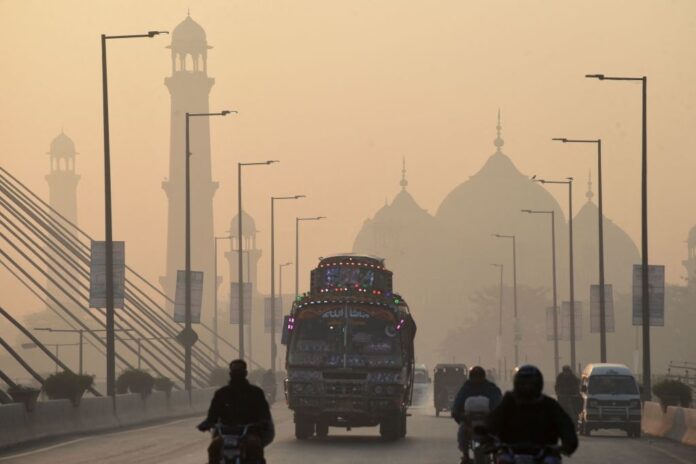LAHORE: Lahore’s air quality reached a record-breaking hazardous level of 707 on Sunday morning, solidifying its position as the most polluted city in the world as thick dust clouds continue to blanket the area, preventing cooler weather from arriving.
According to media reports, various neighborhoods in Lahore reported alarmingly high Air Quality Index (AQI) levels: Thokar Niaz Baig registered an AQI of 878, Johar Town at 893, Syed Maratib Ali Road at 754, and Shahrah-e-Quaid-e-Azam at 633.
The US Consulate recorded an AQI of 700, while Pakistan Engineering Services reported 688. These critically high levels have made Lahore not only Pakistan’s most polluted city but the worst worldwide.
In the provincial capital, stagnant air conditions and low wind speeds have exacerbated pollution levels, with temperatures currently at 23°C and forecasted to reach a maximum of 33°C and a minimum of 22°C over the coming days.
The Meteorological Department has ruled out any chance of rainfall within the next 24 hours, leaving residents to grapple with worsening air quality.
The Punjab Environment Protection Department issued a smog alert for the province on Sunday, noting an abnormal decline in Lahore’s 24-hour average AQI and reduced visibility.
This season’s smog is further intensified by winds transporting polluted air from India, especially from Amritsar, New Delhi, and Chandigarh, at a speed of 7 kilometers per hour. As winter approaches, Lahore’s low-lying location compounds the problem as cold air traps emissions at ground level, preventing dissipation and further deteriorating air quality.
Given the dire conditions, the Punjab government has implemented emergency precautions to protect public health. All outdoor school activities in Lahore have been banned until January 31, 2025, with school hours shifted to 8:45 am beginning October 28. School assemblies are now restricted to indoors, and a ban on fireworks remains in effect until the end of January.
In response to the public health emergency, Lahore traffic police have advised motorcyclists to exercise caution, as visibility has plummeted to as low as one kilometer in some areas.
Environmentalists and medical professionals are calling for an environmental emergency in the city, urging residents to wear masks, avoid unnecessary outings, and limit exposure to the outdoors, particularly for sensitive groups.
Health experts warn that the sustained toxic air will likely lead to widespread respiratory issues, with many residents already reporting coughs, eye irritation, fevers, and sore throats. Those with pre-existing respiratory or heart conditions have been advised to avoid outdoor activities altogether.
The Punjab Environment Department has encouraged citizens to monitor AQI levels, use masks, and take precautions when venturing outside. The Secretary of the Environment Department, Raja Jahangir Anwar, has urged the public to report smoke emissions to the helpline 1373 as part of the government’s anti-smog efforts.
Senior Minister Maryam Aurangzeb acknowledged that while significant anti-smog measures are underway, it may take 8 to 10 years to see substantial improvement in Lahore’s air quality.
She pointed out that only 30% of Lahore’s pollution can be attributed to transboundary smog from India, with the remaining 70% originating locally from low-grade vehicular and industrial emissions, seasonal crop burn-off, and waste incineration.
Out of 45,000 motorcycles in the city, 1,800 emit smoke, along with 100,000 vehicles, 1,200 kilns, and over 60,800 industrial units.
Aurangzeb also highlighted Lahore’s year-round pollution challenge, citing 275 days of unhealthy AQI levels and a rise in the city’s temperatures by 3.2°C over recent years.
To counter local sources of pollution, authorities have demolished 700 brick kilns across Punjab, including 212 in Lahore, and enforced a zero-tolerance policy towards non-compliant industrial units, resulting in the closure of 152 factories and 64 mills.
As a hotspot for global pollution, Lahore has surpassed New Delhi, Cairo, and Karachi, which reported AQIs of 270, 159, and 162, respectively.
The escalating air quality crisis in South Asia, one of the world’s most polluted regions, could reduce life expectancy by over five years per person, according to a recent report. The provincial government has also mobilized anti-smog squads to monitor vehicle emissions rigorously and issued over 400 FIRs against crop residue burners to curb pollution further.
With pollution levels still hazardous and forecasts showing no immediate relief, Lahore residents face a prolonged struggle with the health impacts of extreme air pollution as Punjab authorities continue urgent efforts to control emissions and improve air quality.























